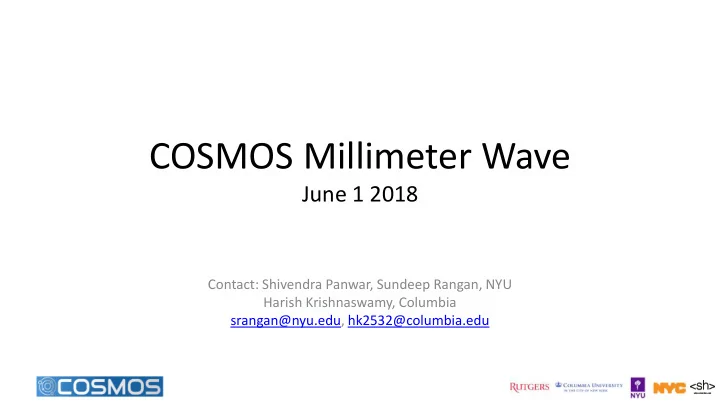

COSMOS Millimeter Wave June 1 2018 Contact: Shivendra Panwar, Sundeep Rangan, NYU Harish Krishnaswamy, Columbia srangan@nyu.edu, hk2532@columbia.edu
Millimeter Wave Communications • Vast untapped spectrum above 6 GHz – Up to 100x more bandwidth – High-dim antenna arrays • But, many challenges for mobile cellular – Path loss, blocking, … From Khan, Pi “Millimeter Wave Mobile Broadband: Unleashing 3-300 GHz spectrum, ” 2011 2
Initial NYU MmWave Measurements • Millimeter wave: It can work! – First measurements in urban canyon environment – Distances up to 200m – Propagation via reflections • Proved feasibility of cellular systems – Measurements made urban macro-cell type deployment – Rooftops 2-5 stories to street-level Rappaport, Theodore S., et al. "Millimeter wave mobile communications for 5G cellular: It will work!." IEEE access 1 (2013): 335-349. 3
Significant Gains Over LTE • System Duplex fc Antenna Cell throughput Cell edge rate MmWave delivers IMT Vision antenna BW (GHz) (Mbps/cell) (Mbps/user, 5%) DL UL DL UL mmW 1 GHz 28 4x4 UE 1514 1468 28.5 19.9 TDD 8x8 eNB 73 8x8 UE 1435 1465 24.8 19.8 8x8 eNB Current 20+20 2.5 (2x2 DL, 53.8 47.2 1.80 1.94 LTE MHz 2x4 UL) FDD ~ 10x gain ~ 25x gain Akdeniz, Mustafa Riza, et al. "Millimeter wave channel modeling and cellular capacity Source: ITU-R IMT-2020 VIsion evaluation”, 2014 -- 10 UEs / cell; 100 m ISD
Rapid Progress in 3GPP • Advanced demos • Several trials underway – VZ, Sprint, AT&T • FCC allocation of 28 and 37 GHz bands • Commercial chip sets Qualcomm, “Making 5G NR a Reality”
Key Challenges for mmWave • Directionality – High isotropic path loss – Compensated by directional beams – Impacts all aspects of cellular design • Blockage – MmWave signals blocked by many common materials – Brick > 80 dB, human body > 25 dB – Leads to highly intermittent channels • What COSMOS can answer: – Can mmWave work on a large scale? – How? 6
COSMOS MmWave Research • Wide Area Channel Measurements – Multi-sites, macro-diversity, blocking, dynamics • Beam forming, adaptive arrays • Beam search, initial access • Scheduling, MAC, idle mode • Networking – Congestion control, multi-path routing, edge networking • Integrated Access / Backhaul • Low latency, high-throughput applications – VR/AR, connected car
COSMOS MmWave Nodes SiBeam 60 GHz • Build powerful SDR platform phased array • 12 steerable – Massive baseband processing elements • 23 dBi gain – Multi-Gbps throughput (large nodes) • 28 GHz phased arrays – Vendor to be decided • Programmable, open interface – Experimentation for beamforming, directional MAC layer, … • Built on 5G OFDM New Radio – Can connect to 5G devices when available NI 5G SDR based on PixE platform
COSMOS MmWave Backhaul • Cellular backhaul for small cells – Currently extremely costly (up to 50% OPEX) – Bottleneck for deployments • MmWave provides low-cost alternative – Potential use in same frequency as access • COSMOS could integrate mmWave backhaul nodes Interdigital 60 GHz EdgeLink antenna - 38 dBi gain - 802.11ad based MiWeba , “ MmWave Evolution for backhaul and access”
mmWave/MIMO at Columbia mmWave CMOS Power Amplifiers with The first mmWave CMOS Phased-Array Record Output Power and Efficiency Transceivers First mmWave Full-Duplex Transceiver First CMOS (massive) MIMO Transceivers
Full-Duplex at Columbia • The Columbia FlexICoN project addresses FD wireless challenges holistically – from the PHY layer to the MAC layer. • We demonstrated the first self- interference cancelling FD RFICs from RF to mmWave. • We demonstrated the first FD antenna interfaces, including CMOS non-magnetic circulators. • We have developed algorithms for resource allocation and evaluated rate gains.
FD Testbed Development Gen 1 FlexICoN FD Node • Frequency-flat RF canceller. • 90dB SIC imparted to 5MHz 0dBm TX signal. Gen 2 FlexICoN Wideband FD Node • Wideband FDE- based RF canceller. • 95dB SIC imparted to 5MHz 5dBm TX Gen 1 node installed in ORBIT signal.
14+ Year History of mmWave Subsystem Research at IBM Leading-edge highly-integrated technology solutions to enable wireless communication and sensor systems with less volume, weight and cost 60-GHz Low-Power Radio in 32nm SOI 60-GHz SiGe Single-Element and Phased Array Radios 94-GHz Scalable Phased Array E-band Fixed-Beam Radio for Backhaul 5G 2003 2005 2007 2009 2015 2017 2011 2013 World’s First Monolithic 94-GHz 64-element Scalable Low-power, Switched 28-GHz 64-element 60GHz 16-Element Phased Array TX+RX Chip-Set Phased Array TX+RX Beam 60GHz CMOS TX+RX Phased Array TX+RX mmWave (60 GHz) Radio
28GHz Phased Array Transceiver Module with 4 ICs and 64 Dual-polarized Antennas (Co-developed by IBM and Ericsson) Module features: • 64-dual polarized antennas and 4 ICs each with 32 TRX elements • 128 TRX elements in total • 8 independent 16- 28GHz phased array eval. board Example outdoor link experiment at IBM element IC2-H IC3-H IC3-V IC2-V beamformers, each IC4-H IC1-H supporting 1 polarization of 16 ant. IC1-V IC4-V • RF true time delay based architecture • 28GHz RF, 5GHz ext. LO, 3GHz TX H/TX V input/output IF • 54dBm saturated EIRP Measured Precise Measured 2 simultaneous Measured 8 simultaneous 1.4 /step beam steering on each polarization 64-element beams 16-element beams
Recommend
More recommend